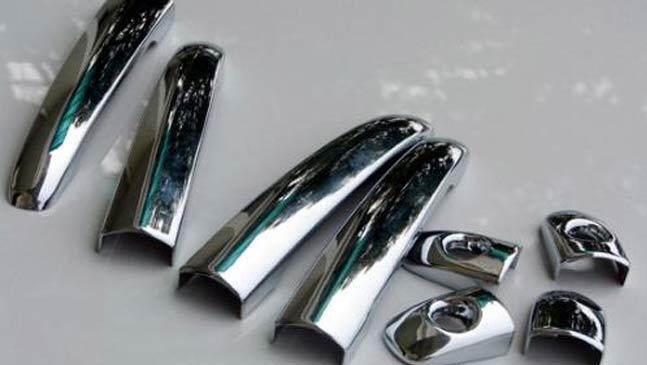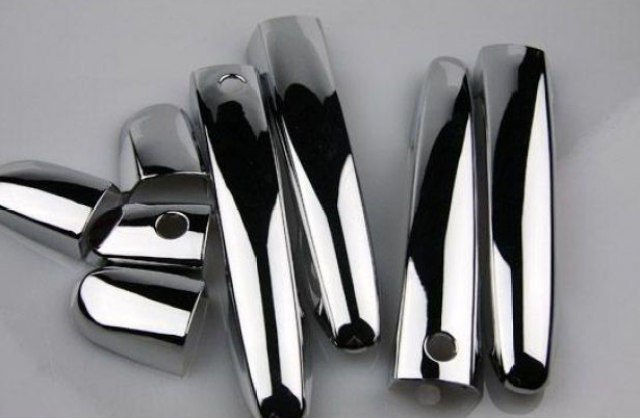Email format error
Email cannot be empty
Email already exists
6-20 characters(letters plus numbers only)
The password is inconsistent
Please enter the email address you’d like your password reset information sent to.
Email format error
Email cannot be empty
Email does not exist
Reset account password
For the account
6-20 characters(letters plus numbers only)
The password is inconsistent
Reset success
Your password was reset. You can log in using your new password.
Login

Offer Technical Support and Customized Solutions
The company is committed to creating new and improved plastic materials to meet the evolving demands of the market.

How to Optimize Injection Molding Process to Improve PC/ABS Plating Performance?
2024-02-18 14:15:52
Introduction
Plated PC/ABS parts are widely used in the automotive, household appliance, and IT industries due to their attractive metallic appearance. PC/ABS Material formulation design and plating processes are typically considered the main factors affecting PC/ABS plating performance; however, few people pay attention to the impact of injection molding processes on plating performance.
1. Injection Molding Temperature
A higher injection molding temperature can achieve better plating performance while ensuring that the material does not decompose. At lower injection molding temperatures, the flowability of PC/ABS material is poor, resulting in products with significant internal stress. Stress release during roughening leads to uneven etching on the product surface, resulting in poor plating appearance and low plating adhesion. Conversely, higher injection molding temperatures can reduce the residual internal stress of the product, thereby improving the plating performance of the material. Research has shown that compared to products with an injection molding temperature of 230°C, increasing the temperature to 260°C-270°C can increase the adhesion of the coating by approximately 50% and significantly reduce the rate of poor surface appearance. However, injection molding temperatures should not be too high, as exceeding the material's decomposition temperature would result in poor surface appearance of the injection molded product, affecting its plating performance.
2. Injection Molding Speed and Pressure
Lower injection molding pressure and appropriate injection molding speed are favorable for improving the plating performance of PC/ABS. Excessive injection molding pressure will lead to excessive squeezing of the internal molecules of the product, resulting in high internal stress and poor plating adhesion. Increasing the injection molding speed appropriately can increase the shearing at the gate position and elevate the fluid temperature, improving the flowability of the entire material, facilitating product filling, and reducing internal stress. However, excessive shearing can result in material decomposition, air streaks, peeling, burrs, and other issues.
3. Holding Pressure and Holding Switching Point
Excessive holding pressure and late holding switching position can lead to product overfilling, stress concentration at the gate position, and high internal residual stress in the product. Therefore, holding pressure and holding switching point should be set based on the actual product filling status.
4. Mold Temperature
High mold temperature is conducive to improving the plating performance of the material. A low mold temperature leads to poor material flowability, severe molecular orientation of the material's chain after cooling due to compression and stretching between molecules during the filling process, resulting in high internal stress of the product and poor plating performance. On the contrary, at high mold temperatures, the material flowability is good, facilitating filling, with molecular chains in a natural coiled state, resulting in low internal stress of the product and a significant improvement in plating performance. Actual mold temperature settings should be based on mold cooling waterways, heating methods, and molding cycle requirements. Mold temperature should be increased as much as possible without affecting other properties. While controlling the mold temperature, it is essential to maintain a uniform temperature distribution in the mold. Non-uniform mold temperature distribution can result in non-uniform shrinkage and internal stress, affecting plating performance.

5. Screw Speed
Lower screw speed is beneficial for improving the plating performance of the material. Screw speed setting determines the metering time of the plastic inflow into the screw for mixing before being conveyed to the nozzle. Screw speed also affects the uniformity of plasticization. Excessive screw speed will intensify material shearing inside the screw, rapidly increasing the melt temperature. Moreover, the faster the screw speed, the poorer the mixing effect of the plastic, leading to a greater temperature difference between the melt, causing differences in the filling flow and cooling, and one of the main reasons for the formation of internal stress in the product. In general, the screw speed setting should be slightly shorter than the cooling time while ensuring material melting.
Conclusion
Injection molding temperature, injection molding speed and pressure, mold temperature, holding pressure, screw speed, etc., all have an impact on the plating performance of PC/ABS. The most direct adverse effect is excessive internal stress in the product, which can affect the uniformity of etching during the roughening stage, thereby affecting the final plating adhesion of the product. In conclusion, by combining product structure, mold condition, and molding machine status, and setting an appropriate injection molding process to reduce material internal stress, the plating performance of PC/ABS material can be significantly improved.
Plated PC/ABS parts are widely used in the automotive, household appliance, and IT industries due to their attractive metallic appearance. PC/ABS Material formulation design and plating processes are typically considered the main factors affecting PC/ABS plating performance; however, few people pay attention to the impact of injection molding processes on plating performance.
1. Injection Molding Temperature
A higher injection molding temperature can achieve better plating performance while ensuring that the material does not decompose. At lower injection molding temperatures, the flowability of PC/ABS material is poor, resulting in products with significant internal stress. Stress release during roughening leads to uneven etching on the product surface, resulting in poor plating appearance and low plating adhesion. Conversely, higher injection molding temperatures can reduce the residual internal stress of the product, thereby improving the plating performance of the material. Research has shown that compared to products with an injection molding temperature of 230°C, increasing the temperature to 260°C-270°C can increase the adhesion of the coating by approximately 50% and significantly reduce the rate of poor surface appearance. However, injection molding temperatures should not be too high, as exceeding the material's decomposition temperature would result in poor surface appearance of the injection molded product, affecting its plating performance.
2. Injection Molding Speed and Pressure
Lower injection molding pressure and appropriate injection molding speed are favorable for improving the plating performance of PC/ABS. Excessive injection molding pressure will lead to excessive squeezing of the internal molecules of the product, resulting in high internal stress and poor plating adhesion. Increasing the injection molding speed appropriately can increase the shearing at the gate position and elevate the fluid temperature, improving the flowability of the entire material, facilitating product filling, and reducing internal stress. However, excessive shearing can result in material decomposition, air streaks, peeling, burrs, and other issues.
3. Holding Pressure and Holding Switching Point
Excessive holding pressure and late holding switching position can lead to product overfilling, stress concentration at the gate position, and high internal residual stress in the product. Therefore, holding pressure and holding switching point should be set based on the actual product filling status.
4. Mold Temperature
High mold temperature is conducive to improving the plating performance of the material. A low mold temperature leads to poor material flowability, severe molecular orientation of the material's chain after cooling due to compression and stretching between molecules during the filling process, resulting in high internal stress of the product and poor plating performance. On the contrary, at high mold temperatures, the material flowability is good, facilitating filling, with molecular chains in a natural coiled state, resulting in low internal stress of the product and a significant improvement in plating performance. Actual mold temperature settings should be based on mold cooling waterways, heating methods, and molding cycle requirements. Mold temperature should be increased as much as possible without affecting other properties. While controlling the mold temperature, it is essential to maintain a uniform temperature distribution in the mold. Non-uniform mold temperature distribution can result in non-uniform shrinkage and internal stress, affecting plating performance.

5. Screw Speed
Lower screw speed is beneficial for improving the plating performance of the material. Screw speed setting determines the metering time of the plastic inflow into the screw for mixing before being conveyed to the nozzle. Screw speed also affects the uniformity of plasticization. Excessive screw speed will intensify material shearing inside the screw, rapidly increasing the melt temperature. Moreover, the faster the screw speed, the poorer the mixing effect of the plastic, leading to a greater temperature difference between the melt, causing differences in the filling flow and cooling, and one of the main reasons for the formation of internal stress in the product. In general, the screw speed setting should be slightly shorter than the cooling time while ensuring material melting.
Conclusion
Injection molding temperature, injection molding speed and pressure, mold temperature, holding pressure, screw speed, etc., all have an impact on the plating performance of PC/ABS. The most direct adverse effect is excessive internal stress in the product, which can affect the uniformity of etching during the roughening stage, thereby affecting the final plating adhesion of the product. In conclusion, by combining product structure, mold condition, and molding machine status, and setting an appropriate injection molding process to reduce material internal stress, the plating performance of PC/ABS material can be significantly improved.
Contact us
PRODUCT TAGS

